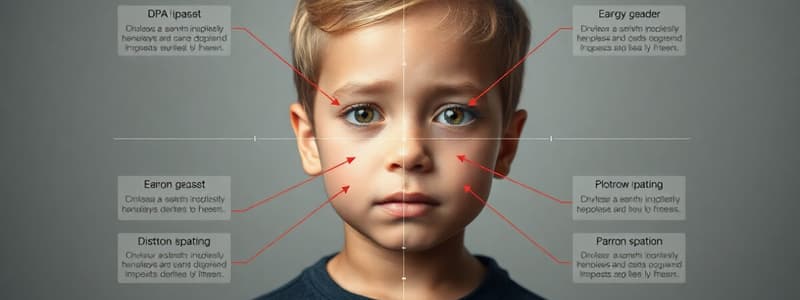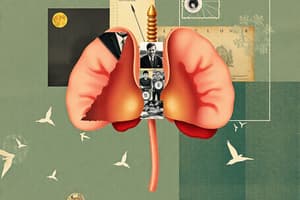Podcast
Questions and Answers
What effect does institutional care during infancy have on the HPA axis?
What effect does institutional care during infancy have on the HPA axis?
- It has no effect on the responsiveness to psychosocial stressors.
- It causes a fluctuation in the responsiveness
- It impairs the responsiveness to psychosocial stressors. (correct)
- It enhances the responsiveness to psychosocial stressors.
What is the Trier social stress test used for in the study?
What is the Trier social stress test used for in the study?
- To assess the level of perceived support.
- To measure cortisol reactivity. (correct)
- To measure changes in pubertal stage.
- To determine between-individual differences.
What did the linear mixed-effects model control for?
What did the linear mixed-effects model control for?
- Sex and between-individual differences in pubertal stage. (correct)
- Only sex.
- Only between-individual differences.
- Stress reactivity levels
According to the study, what is associated with within-individual increases in pubertal stage for postinstitutionalized youth?
According to the study, what is associated with within-individual increases in pubertal stage for postinstitutionalized youth?
What does the study suggest about the peripubertal period?
What does the study suggest about the peripubertal period?
What is the cortisol awakening response (CAR)?
What is the cortisol awakening response (CAR)?
According to Romeo's argument, what is significant about the peripubertal period?
According to Romeo's argument, what is significant about the peripubertal period?
What do the cross-sectional studies indicate about the CAR for children with early life stress at later pubertal stages?
What do the cross-sectional studies indicate about the CAR for children with early life stress at later pubertal stages?
What was calculated to model between-individual differences in pubertal stage?
What was calculated to model between-individual differences in pubertal stage?
How was within-individual change in pubertal stage calculated?
How was within-individual change in pubertal stage calculated?
What does the HPA axis appear to do post-adoption?
What does the HPA axis appear to do post-adoption?
What is the likely reason for the HPA axis recalibrating prior to the reproductive period?
What is the likely reason for the HPA axis recalibrating prior to the reproductive period?
What is suggested to allow a 'disproportionately large influence' on HPA axis function?
What is suggested to allow a 'disproportionately large influence' on HPA axis function?
What factor was explored as a possible modifier of the pubertal stress recalibration effect?
What factor was explored as a possible modifier of the pubertal stress recalibration effect?
Which of the following best describes how puberty impacts HPA axis functioning?
Which of the following best describes how puberty impacts HPA axis functioning?
What was specifically stated to be 'unlikely' to be responsible for driving recalibration?
What was specifically stated to be 'unlikely' to be responsible for driving recalibration?
What does 'longitudinal change in pubertal score' refer to in the provided study?
What does 'longitudinal change in pubertal score' refer to in the provided study?
What is the 'mean pubertal stage' used to model in the study?
What is the 'mean pubertal stage' used to model in the study?
What does the study investigate by moderating pubertal stage variables by group (PI vs NA)?
What does the study investigate by moderating pubertal stage variables by group (PI vs NA)?
What is the focal predictor in the study's statistical models?
What is the focal predictor in the study's statistical models?
Why does the study control for sex and sex interactions?
Why does the study control for sex and sex interactions?
What is a possible benefit of recalibrating the HPA axis during puberty?
What is a possible benefit of recalibrating the HPA axis during puberty?
What does the text suggest regarding the timing of interventions to improve children's environments?
What does the text suggest regarding the timing of interventions to improve children's environments?
What type of data is available on GitHub, according to the text?
What type of data is available on GitHub, according to the text?
What was the age range of the participants at the start of the study?
What was the age range of the participants at the start of the study?
How many participants were identified as previously institutionalized (PI) in the study?
How many participants were identified as previously institutionalized (PI) in the study?
What is the mean age at which the PI youth were adopted?
What is the mean age at which the PI youth were adopted?
Approximately what percentage of their pre-adoptive life did PI youth spend in the institution?
Approximately what percentage of their pre-adoptive life did PI youth spend in the institution?
What was the primary goal of matching PI and NA families?
What was the primary goal of matching PI and NA families?
Which of the following was NOT listed as a source of funding for this study?
Which of the following was NOT listed as a source of funding for this study?
Who was responsible for Tanner staging in this study?
Who was responsible for Tanner staging in this study?
Which of these is NOT mentioned as a thank you in the acknowledgements?
Which of these is NOT mentioned as a thank you in the acknowledgements?
Which hormone is most closely associated with the studies of stress responsivity and hypothalamic-pituitary-adrenal (HPA) axis regulation?
Which hormone is most closely associated with the studies of stress responsivity and hypothalamic-pituitary-adrenal (HPA) axis regulation?
What is a notable period that seems to have significant impact on developmental plasticity and stress responsivity?
What is a notable period that seems to have significant impact on developmental plasticity and stress responsivity?
What does the term 'hypocortisolism' refer to?
What does the term 'hypocortisolism' refer to?
What is a specific developmental process that glucocorticoids, like cortisol, regulate?
What is a specific developmental process that glucocorticoids, like cortisol, regulate?
What impact can early-life stress have on an adult's diurnal cortisol pattern?
What impact can early-life stress have on an adult's diurnal cortisol pattern?
Which of the following best describes the 'adaptive calibration model'?
Which of the following best describes the 'adaptive calibration model'?
What is the relationship between parenting behaviors and child behavior as it is assessed in a particular study mentioned?
What is the relationship between parenting behaviors and child behavior as it is assessed in a particular study mentioned?
According to a study mentioned, what are some of the impacts that severe institutional deprivation in childhood can have on adult adoptees?
According to a study mentioned, what are some of the impacts that severe institutional deprivation in childhood can have on adult adoptees?
What was the primary focus of the study?
What was the primary focus of the study?
What does TSST-C stand for, in the context of the study?
What does TSST-C stand for, in the context of the study?
Which group showed increased cortisol reactivity with increasing pubertal stage?
Which group showed increased cortisol reactivity with increasing pubertal stage?
What statistical method was primarily used to analyze the data?
What statistical method was primarily used to analyze the data?
According to the study, how was the cortisol response measured?
According to the study, how was the cortisol response measured?
What previous research or models does this study corroborate?
What previous research or models does this study corroborate?
How was pubertal status assessed in this study?
How was pubertal status assessed in this study?
When were the majority of the postinstitutionalized youth adopted?
When were the majority of the postinstitutionalized youth adopted?
Flashcards
Cortisol
Cortisol
The hormone released in response to stress, measured through saliva samples.
TSST-C (Trier Social Stress Test for Children)
TSST-C (Trier Social Stress Test for Children)
A test used to measure an individual's stress response through physiological changes.
Puberty
Puberty
The period of physical and hormonal changes that lead to sexual maturity.
Institutionalized
Institutionalized
Signup and view all the flashcards
Stress Reactivity
Stress Reactivity
Signup and view all the flashcards
Cortisol Recovery
Cortisol Recovery
Signup and view all the flashcards
Within-individual Changes
Within-individual Changes
Signup and view all the flashcards
Linear Mixed-Effects Model
Linear Mixed-Effects Model
Signup and view all the flashcards
What is the HPA axis?
What is the HPA axis?
Signup and view all the flashcards
What is puberty?
What is puberty?
Signup and view all the flashcards
What does recalibration mean?
What does recalibration mean?
Signup and view all the flashcards
What is early life stress?
What is early life stress?
Signup and view all the flashcards
What is institutional care?
What is institutional care?
Signup and view all the flashcards
How does institutional care affect the HPA axis?
How does institutional care affect the HPA axis?
Signup and view all the flashcards
Can the HPA axis recalibrate during puberty?
Can the HPA axis recalibrate during puberty?
Signup and view all the flashcards
How does the HPA axis respond during puberty for those with early life stress?
How does the HPA axis respond during puberty for those with early life stress?
Signup and view all the flashcards
Pubertal HPA axis recalibration
Pubertal HPA axis recalibration
Signup and view all the flashcards
Cortisol reactivity
Cortisol reactivity
Signup and view all the flashcards
Mean pubertal stage
Mean pubertal stage
Signup and view all the flashcards
Within-individual pubertal change
Within-individual pubertal change
Signup and view all the flashcards
Puberty as a window of plasticity
Puberty as a window of plasticity
Signup and view all the flashcards
HPA axis
HPA axis
Signup and view all the flashcards
Neural plasticity
Neural plasticity
Signup and view all the flashcards
Postinstitutionalized Individuals
Postinstitutionalized Individuals
Signup and view all the flashcards
Recalibration
Recalibration
Signup and view all the flashcards
HPA Axis Functioning
HPA Axis Functioning
Signup and view all the flashcards
Peripubertal Period
Peripubertal Period
Signup and view all the flashcards
Group Differences in Stress Response
Group Differences in Stress Response
Signup and view all the flashcards
Recalibrating the HPA Axis
Recalibrating the HPA Axis
Signup and view all the flashcards
Study Notes
Correction for "Pubertal stress recalibration reverses the effects of early life stress in postinstitutionalized children"
- The original publication of the study, "Pubertal stress recalibration reverses the effects of early life stress in postinstitutionalized children," incorrectly omitted an author.
- Bradley S. Miller should be added to the author list, following Bonny Donzella.
- Miller's contribution was research performance.
- The corrected author list, affiliation, and author contributions are now included in the online version.
Pubertal Stress Recalibration
- Nonhuman animal studies show the hypothalamic-pituitary-adrenocortical (HPA) axis calibrates to environmental conditions during infancy.
- Children institutionalized in infancy show reduced HPA axis reactivity even after placement in supportive homes.
- This study investigated whether puberty enables HPA axis recalibration in postinstitutionalized children.
- 129 postinstitutionalized children (68.2% female) and 170 comparison children (52.4% female) participated in 3 annual sessions from ages 7 to 15.
- Pubertal stage was assessed annually using nurse examinations.
- Cortisol reactivity was measured using the Trier Social Stress Test for Children (TSST-C).
- A significant interaction was observed between group (postinstitutionalized vs. comparison) and pubertal stage.
- Increased cortisol stress reactivity was found in postinstitutionalized youth with increasing pubertal stages.
- This effect was not observed in comparison youth.
- Puberty offers a second sensitive period for HPA axis recalibration, contingent on supportive environments.
- Interventions for children with early-life adversity should focus on the prepubertal and peripubertal period for optimal impact on stress-mediating systems.
Studying That Suits You
Use AI to generate personalized quizzes and flashcards to suit your learning preferences.




